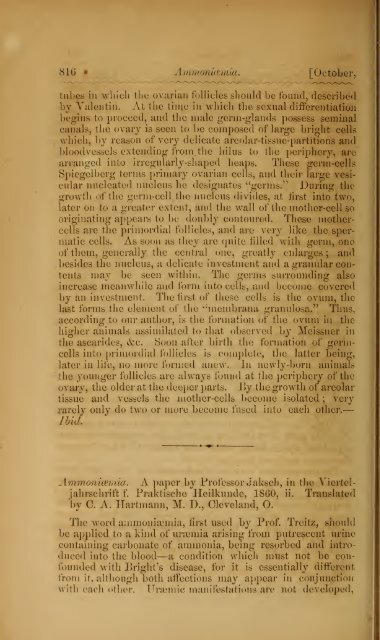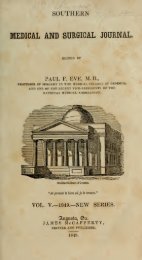L861.J Develop toftk Follicles of the Ovaries, £c. 8151>. They project1with their free surface , which is covered*withthe venous epithelium (the Bpleriic fibres of earlierauthors) into the cavities of the cavernous network ; themeshes, consisting of areolar tissue, go between the epithelialcells with the Malpighian bodies, ami become narrowerwithin them. On each Malpighian corpuscle, beneath thevenous epithelium, runs a small arterial vessel which becomeslost on its surface (in a tuft-like manner) in ;i great number ofcapillary twigs, many of which allow but a r.ingle blood corpuficleto pass. The capillary wsr-ols pass from the surfaceinto the interior of the Malpighian corpuscles, and becomelarger within, owing to the concurrence of many twigs. Aftertheir union in a central vein, this passes out into the surroundingcavernous network to embouchure into a larger vein.etiinee, hut rarely, Bmaller isolated veins also pass fromthese bodies in addition to the central vein. The larger centralvessels are evidently veins, not only from their emptyinginto larger veins, hut also from their walls being thinner thanthose of arteries, and from their having the characteristicepithelial cells of splenic veins on their inner surface. Thespace between the- meshes of the cavernous network in thesplenic corp: filled with white blood-corpuscles, whichonly a<strong>pp</strong>ear to differ from those in the body generally by theirbeing smaller, and having a BOmewhat clearer outline. Thismay be from the deficiency of fluid. On ligaturing theinic artery of a t\'j:, and killing it some days afterwards, itwill he found that \\ic central vein of each splenic corpusclemay he seen with the naked eye as a red point on a whiteground, and the corpuscles a<strong>pp</strong>ear enlarged. Moreover, thecentral vein may he seen very clearly in the spleen in c,wherein >oine time previous to death the sympathetic nerveaddressed to the spleen has been divided.— Ibid.•],, J'), /, loprru at of tin Follicli 8 of //>> Ovarii a and of tinOvum in tl- mammalia. By Otto Spiegelberg.The following ations were conducted n the humanenduy... a- well a- on the embryonic and newly-born rabbits,The author was unable t'«» recognise thetKon: Ges : der Wiss. zu Gottiu i,Juli, No. 20; aa quoted inVirchow'fl Arohiv. Band rx. I!. 2<strong>10</strong>.
—Mi; Ammomcemh. [<strong>October</strong>,tubes in which the ovarian follicles should be found, describedby Valentin. At the time in which the sexual differentiationbegins to proceed, and the male germ-glands possess seminalcanals, the ovary is seen to be composed of large bright cellswhich, by reason of very delicate areolar-tissue-partitions andbloodvessels extending from. the hiius to the periphery, arearranged into irregularly-shaped heaps. These germ-cellsSpiegelberg terms primary ovarian cells, and their large vesicularnucleated nucleus he designates "germs.'' During thegrowth of the germ-cell the nucleus divides, at first into two,later on to a greater extent, and the wall of the mother-cell sooriginating a<strong>pp</strong>ears to he doubly contoured. These mothercellsare the primordial follicles, and are very like the spermaticcells. As soon as they are quite tilled with germ, oneof them, generally the central one, greatly enlarges; andbesides the nucleus, a delicate investment and a granular contentsmay be seen within. The germs surrounding alsoincrease meanwhile and form into cells, and become coveredby an investment. The first of these cells is the ovum, thelast forms the element of the "membrana granulosa." Thus,according to our author, is the formation of the ovum in thehigher animals assimilated to that observed by Meissner inthe ascarides, &c. Soon after birth the formation of germcellsinto primordial follicles is complete, the latter being,later in life, no more formed anew. In newly-born animalsthe younger follicles are always found at the periphery of theovary, the older at the deeper parts. .By the growth of areolartissue and vessels the mother-cells become isolated; veryrarely only do two or more become fused into each other.Ibid.Aramonuvhuo. A paper by Professor Jaksch, in the Vierteljahrschriftf. Praktische Heilkunde, 1S60, ii. Translatedby C. A. Hartmann, M. I)., Cleveland, O.The word ammonhmma, first used by Prof. Treitz, shouldbe a<strong>pp</strong>lied to a kind of uraemia arising from putrescent urinecontaining carbonate of ammonia, being resorbed and introducedinto the blood—a condition which must not be confoundedwith Blight's disease, for it is essentially differentfrom it, although both affections may a<strong>pp</strong>ear in conjunctionwith each other, drsemic manifestations are not developed,
- Page 1 and 2:
SOUTHERNfttcMcai avto Surgical Imtt
- Page 3 and 4:
practical754 i;i'Ji J'oXes, on the
- Page 5 and 6:
756 Joseph Jones, on the Indigenous
- Page 7 and 8:
;7 58 Joseph J ones, on the Indigen
- Page 9 and 10:
760 Joseph Jones, on the Indigenous
- Page 11 and 12:
762 3EPflJoKfis, bn the Indigenous
- Page 13 and 14: 764 Joseph Jones, on the Indigenous
- Page 15 and 16: 7'!
- Page 17 and 18: —'.emeticssbfhJohi[Octobameliorat
- Page 19 and 20: 770 Joseph Jones, on the Indigenous
- Page 21 and 22: 77-? Joseph Jones, on the Indigenou
- Page 23 and 24: 7 74 Joseph Jones, on the Indigenou
- Page 25 and 26: 776 Joseph Jones, on 1 the Indigeno
- Page 27 and 28: 778 Joseph Jones, on the Indigenous
- Page 29 and 30: 780 Joseph Jokes, on (he Indigenous
- Page 31 and 32: 782 Joseph Jones, on the Indigenous
- Page 33 and 34: :784 Joseph Jones, on the Indigenou
- Page 35 and 36: —786 Joseph Jones, on the Indigen
- Page 37 and 38: 788 Dvphtlima. [October,to confound
- Page 39 and 40: 700 Diphtheria. [October,*almost in
- Page 41 and 42: 792 Diphtheria. [October,in water a
- Page 43 and 44: 704 Diphtheria: [October,find favor
- Page 45 and 46: 796 Diphtheria. [October,tongue. \)
- Page 47 and 48: 798 Uterine Inflammation. October,b
- Page 49 and 50: 800 Uterine Inflammation. [October,
- Page 51 and 52: 802 Uterine Inflammation. [October,
- Page 53 and 54: elhrai804 me Inflammation. [October
- Page 55 and 56: ;806 Phlegmasia Dolens. [October,Th
- Page 57 and 58: SOS Termination ofNerves. [October,
- Page 59 and 60: cl Termination of Nerv October,] to
- Page 61 and 62: —812 Development of Bloodvessels.
- Page 63: —814 ( orpuscles of the Spleen. [
- Page 67 and 68: 818 Ammoniamia. [October,v^^%/\yof
- Page 69 and 70: 820 Arnmoniccraia. [October,combine
- Page 71 and 72: 822 Ammonicemia, [October,all, requ
- Page 73 and 74: 824 Galcano Cautery in Cataract. [O
- Page 75 and 76: —826 Editorial. [October,MEDICAL
- Page 77 and 78: ———828 Miscellaneous. [Octobe
- Page 79 and 80: ———830 Miscellaneous. [Octobe
- Page 81: —832 Miscellaneous.was employed f








